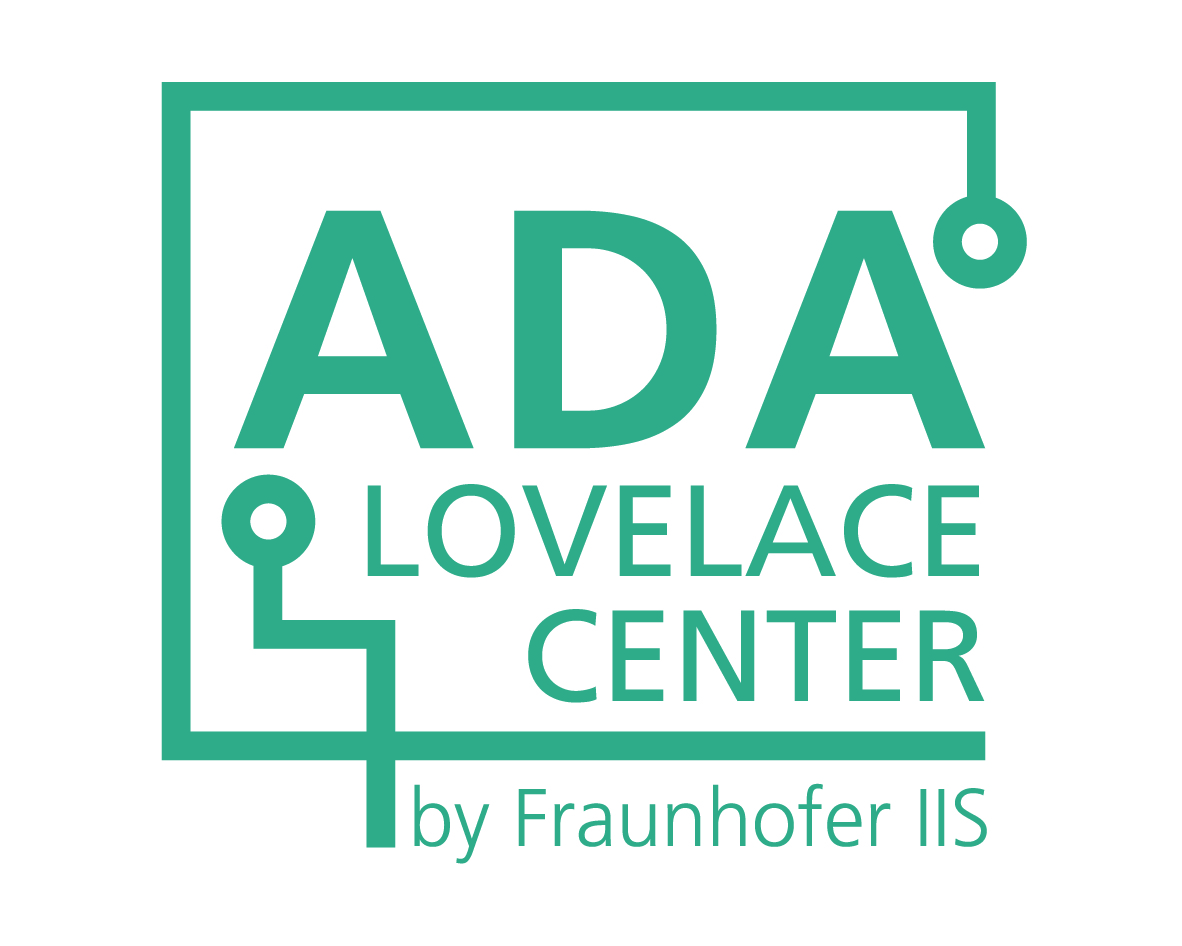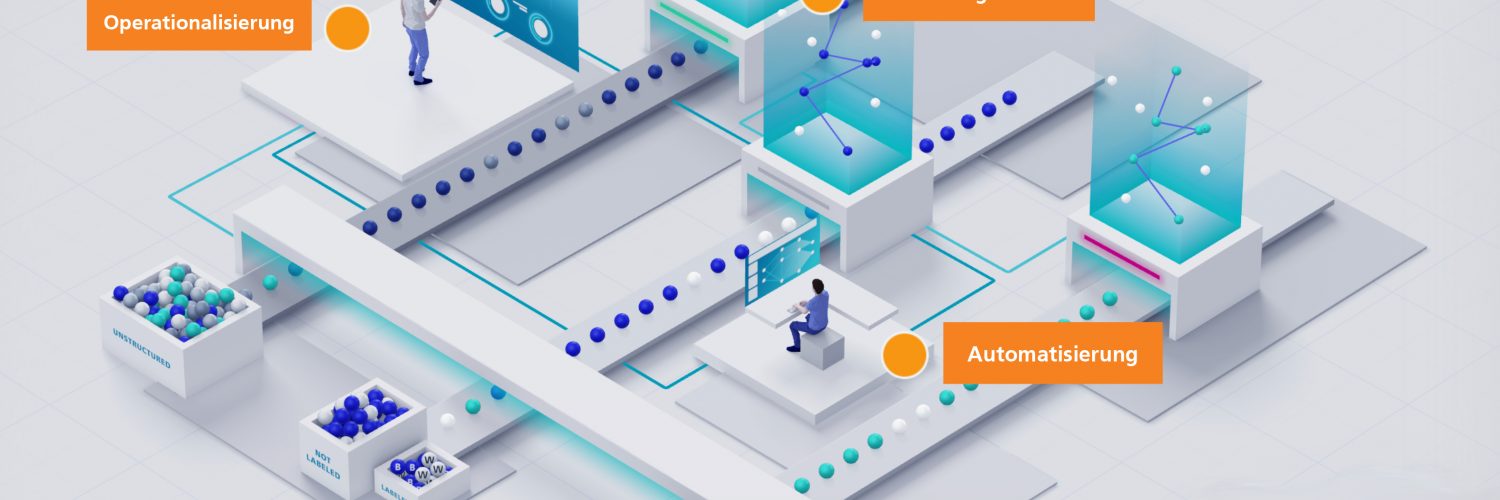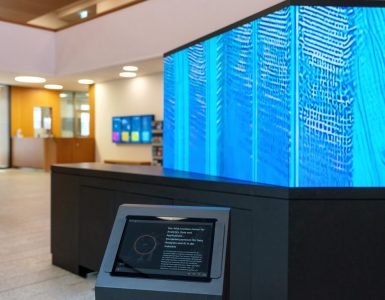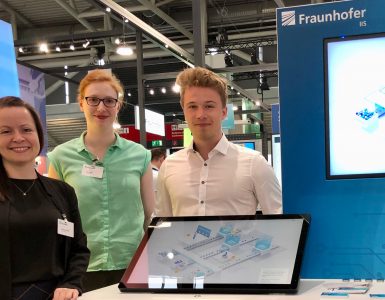Dr. Paulina Sierak ist Leiterin der Gruppe »Data Efficient Automated Learning« der Arbeitsgruppe für Supply Chain Services des Fraunhofer IIS in München und damit auch Teil des ADA Lovelace Center. Die Expertinnen und Experten der Gruppe bearbeiten die Kompetenzsäulen »Automated Learning« und »Data-Centric AI« und entwickeln in diesem Rahmen Lösungen für den Einsatz effizienter KI innerhalb des gesamten Machine Learning-Lifecycle. Um hierzu neue und spannende Einblicke in die Automotive Industrie zu gewinnen und den Branchenexperten widerum die Vorteile ressourceneffizienter KI vorzustellen, hielt Dr. Paulina Sierak beim Automobil Produktion Kongress in München einen Vortrag und nahm an der anschließenden Paneldiskussion mit Dr. Rüdiger Recknagel, Leiter Umweltschutz für den Audi Konzern, teil. Ich habe mit ihr gesprochen und freue mich nun etwas mehr darüber zu erfahren.
Hi Paulina, was waren denn deine Highlights auf dem Automobil Produktion Kongress?
Paulina: Was ich persönlich sehr spannend fand, waren die Einblicke in die neuen Entwicklungen unterschiedlicher Automobil Produktionsstätten und der Zulieferindustrie. Im Fokus stand ganz klar die Digitalisierung in verschiedensten Formen. Einerseits wurden unterschiedliche IoT-Technologien betrachtet und Einsatzmöglichkeiten von KI in der Produktion aber auch in der Lieferkette, andererseits auch Lösungen diskutiert, wie die Automobilindustrie grüner und nachhaltiger werden kann. Es wird immer klarer, dass die Verschmelzung von Digitalisierung, KI und Nachhaltigkeit eine zentrale Rolle in der Automobilindustrie spielt und diese, als wichtigster Industriezweig in Deutschland, hier mit großen Schritten voranschreiten muss.
Welche neuen Erkenntnisse hast du dort ganz allgemein und in Bezug auf die Forschung im ADA Lovelace Center gewonnen?
Paulina: Auf dem Kongress habe ich den Eindruck gewonnen, dass die Automobilindustrie die Rolle der Innovationsführerschaft in Deutschland, insbesondere was den Einsatz von digitalen Technologien in der Produktion angeht, sehr ernst nimmt. Ich denke, das gilt insbesondere für die OEM als auch Tier 1-Zulieferer. Aus Sicht der angewandten Forschung ist es schön zu sehen, dass auch KI-Anwendungsfälle mehr und mehr zum produktiven Einsatz kommen. Damit ebnet die Automobilindustrie auch den Weg für andere Industriezweige und kleinere Unternehmen in ihrer Branche.
Mit Blick auf gezeigte Lösungen und auch die aufgeworfenen Fragen auf dem Kongress, finde ich, dass wir mit dem ADA Lovelace Center an den richtigen Themen arbeiten, um für den Bedarf der Industrie Lösungen zu bieten. Hier sehe ich ein großes Potenzial, unsere entwickelten KI-Methoden und geschaffenen KI-Kompetenzen in unterschiedlichen Anwendungen zum Einsatz zu bringen.
Aber die Innovationsführerschaft bezieht sich nicht nur auf die digitalen Technologien. Auch im Bereich Nachhaltigkeit konnte ich den Eindruck gewinnen, dass die Unternehmen das Ziel verfolgen, ihre Werke und Prozesse dahingehend zu optimieren und ressourcenschonender zu gestalten. Nachhaltigkeit ist auch ein wichtiger Aspekt im ADA Lovelace Center: wir entwickeln hier beispielsweise Methoden, die bereits zur energieeffizienten Fahrplanoptimierung eingesetzt wurden und auch für die Produktion relevant sein können.
Was würdest du als Schlüsselfaktoren im weiteren Prozess der Nachhaltigkeit für die Automobilproduktion sehen? Und was könnt ihr als Expertinnen und Experten des ADA Lovelace Center dazu beitragen?
Paulina: Es sind mir ganz besonders drei Faktoren aufgefallen: Innerhalb der Panel-Diskussion mit Dr. Recknagel von Audi kamen wir zu dem Ergebnis, dass Reduktion (Reduce) der größte Schlüssel im Bezug auf Nachhaltigkeit ist – dem stimmte auch das Publikum zu. Weitere wichtige Faktoren sind die Kreislaufschließung durch Wiederverwertung aber auch die Verlängerung von Produktlebenszyklen.
Ich persönlich kann dies aber auch nur aus Sicht der Digitalisierung bzw. KI wirklich beanworten: Für genau diese oben beschriebenen Themen kann es oft notwendig sein, erst Transparenz zu schaffen, bevor Maßnahmen ergriffen werden können. Manchmal kann aufgrund der Komplexität KI dabei hilfreich sein und hier setzen die Forschungsthemen des ADA Lovelace Center an. Beispielhaft seien hier Bedarfs-/Ressourcenprognosen aus der Kompetenzsäule »Sequenzbasiertes Lernen« oder die Optmierung und damit Reduktion von Energie in der Kompetenzsäule »Mathematische Optimierung« genannt.
Aber auch die KI selbst benötigt Ressourcen, sei es durch Daten- oder Rechenaufwand, der möglichst gering gehalten werden muss, womit wir uns in den Säulen »Data-Centric AI« und »Automated Learning« beschäftigen.
Und das eine Event ist zu Ende da steht das nächste schon vor der Tür: vom 27.06. bis zum 30.06. findet die automatica in München statt – Leitmesse für intelligente Automation und Robotik. Die großen Fokusthemen in diesem Jahr sind Digitalisierung und KI | Nachhaltige Produktion | Zukunft der Arbeit. Die Gruppe Data Efficient Automated Learning wird auch mit einem Stand vertreten sein – worauf freust du dich besonders?
Paulina: Das wird ein ganz besonderer Tag für uns, denn es ist der erste Messeauftritt der Gruppe Data Efficient Automated Learning. Unsere Gruppe ist die ADA Lovelace Center Forschungsgruppe in München und arbeitet in enger Kooperation mit der Ludwig-Maximilians-Universität zusammen. Daher und aufgrund unserer Themen und Projekten rund um den Forschungsbereich »Efficient AI«, die wir auf dem Fraunhofer-Gemeinschaftstand vorstellen, liegt es nahe, dass wir diese Messe besuchen. Unser persönliches Highlight ist natürlich unser gleichnamiger Spieldemonstrator.
Das klingt spannend, was können wir vom Spieldemonstrator erwarten oder was können wir uns darunter vorstellen?
Paulina: Mit unserem Demonstrator wollen wir Messebesucher*innen einen Einblick geben in den Machine Learning Lifecycle – also den Lebenszyklus eines KI-Systems von den Daten bis hin zur Wartung und Instandhaltung der Modelle. Wir wollen zeigen, an welchen Stellen die Ressourcen Mensch und Daten innerhalb dieses Lebenszyklus relevant sind und wie diese sinnvoll und in gutem Maße eingesetzt werden können. Das zu wissen ist notwendig, um die Möglichkeiten und den Aufwand des Einsatzes von KI im eigenen Unternehmen realistisch abschätzen zu können.
Dank unseres Demonstrators können Messebesucher*innen spielerisch erfahren, wie aufwendig und auch repetitiv der Prozess sein kann, bis man ein gutes KI-Modell trainiert hat und auch, wie AutoML hier Abhilfe schaffen kann. Dazu lassen wir sie gegen unser AutoML-Tool antreten, das das Training und die Optimierung automatisiert. So können wir zeigen, dass man mit Automatisierung den Data Scientist bei repetitiven und »simplen« Aufgaben entlasten kann. Somit bleibt mehr Zeit für die Entwicklung von Use Cases.
Aber wir haben natürlich nicht nur ein Spiel dabei, sondern auch diverse Deep Dives zu unseren Kompetenzsäulen »Data-Centric AI« und »Automated Learning«, aufbereitet entlang des KI-Lebenszyklus in einer virtuellen Welt.
Es ist der erste Messeauftritt der Gruppe Data Efficient Automated Learning – welches Ziel verfolgt ihr damit oder wann würdest du sagen, dieser war erfolgreich?
Paulina: In erster Linie hoffen wir mit unserem Messeauftritt ein Bewusstesein für die Relevanz von Ressourceneffizienz und Automatisierung der KI selbst zu schaffen und Interesse für unsere Lösungen zu wecken. Den Austausch mit den Messebesucher*innen, die Sichtbarmachung der Forschungsrelevanz zu unseren Kompetenzsäulen »Data-Centric AI« und AutoML sowie spannende Kontakte und Projektideen für neue Forschungskooperationen würde ich als Erfolg sehen.
Vielen Dank Paulina für die interessanten Einblicke und ich freue mich schon darauf, mehr von eurem Spieledemonstrator zu sehen. Hier gibt es einen ersten Eindruck:
#ADAunderway: Efficient AI in production and logistics
Dr. Paulina Sierak is the head of the „Data Efficient Automated Learning“ group within the Center for Applied Research on Supply Chain Services at Fraunhofer IIS in Munich, and is also part of the ADA Lovelace Center. The experts in the group work on the pillars of „Automated Learning“ and „Data-Centric AI“ and develop solutions for the use of efficient AI throughout the entire machine learning lifecycle. In order to gain new and exciting insights into the automotive industry and to present the advantages of resource-efficient AI to industry experts, Dr. Paulina Sierak gave a lecture at the Automotive Production Congress in Munich and participated in the subsequent panel discussion with Dr. Rüdiger Recknagel, Head of Environmental Protection for the Audi Group. I spoke with her and am now excited to learn more about it.
Hi Paulina, what were your highlights at the Automobile Production Congress?
Paulina: What I personally found very exciting were the insights into the new developments of various automotive production plants and the supplier industry. The focus was clearly on digitization in various forms. On the one hand, different IoT technologies and the use of AI in production and the supply chain were examined, and on the other hand, solutions were discussed on how the automotive industry can become greener and more sustainable. It is becoming increasingly clear that the convergence of digitization, AI and sustainability plays a central role in the automotive industry, which, as the most important industry sector in Germany, must make significant progress in these areas.
What new insights did you gain there in general and in relation to research at the ADA Lovelace Center?
Paulina: At the congress, I gained the impression that the automotive industry takes the role of innovation leadership in Germany very seriously, especially when it comes to the use of digital technologies in production. I think this applies particularly to OEMs and Tier 1 suppliers. From the perspective of applied research, it is nice to see that AI use cases are increasingly being put into productive use. In doing so, the automotive industry is also paving the way for other industry sectors and smaller companies in their field.
Looking at the solutions presented and the questions raised at the congress, I think we are working on the right topics at the ADA Lovelace Center to provide solutions that meet the needs of the industry. I see great potential in applying our developed AI methods and created AI competencies in various applications.
But innovation leadership is not only related to digital technologies. I also gained the impression that companies in the automotive industry are pursuing the goal of optimizing their plants and processes to be more resource-efficient and environmentally friendly. Sustainability is also an important aspect at the ADA Lovelace Center: for example, we develop methods that have already been used for energy-efficient timetable optimization and can also be relevant for production.
What would you see as key factors in the further process of sustainability for automotive production? And what can you as ADA experts contribute to this?
Paulina: I noticed three particular factors: During the panel discussion with Dr. Recknagel from Audi, we came to the conclusion that reduction is the key factor in terms of sustainability – the audience agreed as well. Other important factors are closed-loop recycling and the extension of product lifecycles.
Personally, I can only answer this from the perspective of digitization and AI.
For precisely these topics described above, it is often necessary to create transparency before measures can be taken. Sometimes AI can be helpful due to its complexity, and this is where the research topics of the ADA Lovelace Center come in. As examples, we have demand/resource forecasting from the „Sequence-based Learning“ competence pillar or optimization and energy reduction in the „Mathematical Optimization“ competence pillar.
But AI itself also requires resources, whether it be data or computational power, which need to be kept as minimal as possible, and that is what we focus on in the »Data-Centric AI« and »Automated Learning« pillars.
And as one event ends, the next one is just around the corner: from June 27th to June 30th, the automatica trade fair will take place in Munich – the leading trade fair for intelligent automation and robotics. The major focus topics this year are digitization and AI | sustainable production | the future of work. The Data Efficient Automated Learning group will also have a booth – what are you particularly excited about?
Paulina: It will be a very special day for us because it is the first trade fair appearance of the Data Efficient Automated Learning group. Our group is the ADA Lovelace Center research group in Munich and works closely with Ludwig Maximilian University. Therefore, due to our topics and projects related to the research area of „Efficient AI“, which we will present at the Fraunhofer joint booth, it is natural for us to attend this trade fair. Our personal highlight is, of course, our eponymous game demonstrator.
That sounds exciting, what can we expect from the game demonstrator or what can we imagine it to be?
Paulina: With our demonstrator, we want to give trade fair visitors an insight into the machine learning lifecycle – the lifecycle of an AI system from data to the maintenance and upkeep of models. We want to show where the resources of humans and data are relevant within this lifecycle and how they can be effectively and appropriately utilized. Knowing this is necessary to realistically assess the possibilities and effort involved in implementing AI in one’s own company.
Thanks to our demonstrator, trade fair visitors can playfully experience how complex and repetitive the process can be until a good AI model is trained, as well as how AutoML can help. We let them compete against our AutoML tool, which automates training and optimization. This way, we can show that automation can relieve data scientists of repetitive and „simple“ tasks. Thus, more time is available for developing use cases.
But we don’t just have a game; we also have various deep dives into our competence pillars »Data-Centric AI« and »Automated Learning«, presented along the AI lifecycle in a virtual world.
It is the first trade fair appearance of the Data Efficient Automated Learning group – what goal do you pursue with it or when would you say it was successful?
Paulina: First and foremost, we hope to create awareness for the relevance of resource efficiency and automation of AI itself with our trade fair appearance and to generate interest in our solutions. I would consider it a success to have discussions with trade fair visitors, to demonstrate the research relevance of our competence pillars »Data-Centric AI« and AutoML, and to establish exciting contacts and project ideas for new research collaborations.





